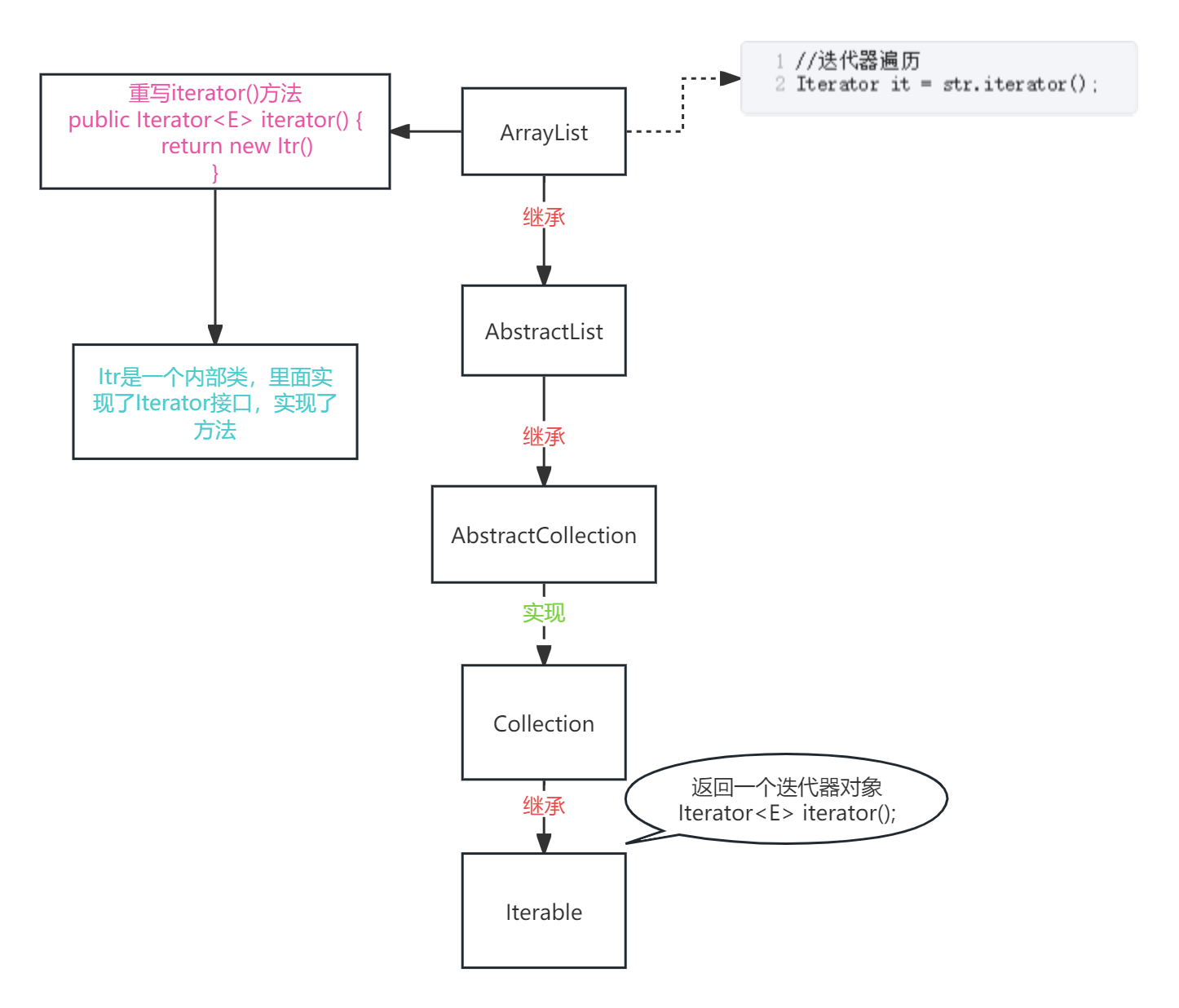写在开头
某大厂的面试现场,一位目光深邃,头顶稀疏的中年面试官坐在椅子上,这时候的我走了进来。
面试官:“小伙子,学过Java中容器和数据结构了吧?”
我:“嗯,学了”
面试官:“ok,那你来聊一聊Java中的迭代器(Iterator ),要说清楚他们的应用场景哈”
我:“哦,好滴”
内心独白:“这面试官不按套路出牌啊,本来以为会问问ArrayList,HashMap呢,或者手撕排序算法,这上来直接让撕迭代器”
虽然面试官不按套路出牌,但这时我们也不能乱,迅速的平复心情后,大脑飞速运转,回想着之前学的内容,其实迭代器和比较器确实在容器和数据结构中有所体现。
Iterator (迭代器)
在解释迭代器之前,我们先来聊一下23种设计模式之一:迭代器模式,它是 Java 中常用的设计模式之一。用于顺序访问集合对象的元素,无需知道集合对象的底层实现。
而Iterator则是在这种设计思想下诞生的产物,Iterator 是可以遍历集合的对象,为各种容器提供了公共的操作接口,隔离对容器的遍历操作和底层实现,从而解耦。
【源码解析1】
public interface Iterator<E> { //是否有下一个元素 boolean hasNext(); //下一个元素 E next(); //从迭代器指向的集合中删除迭代器返回的最后一个元素 default void remove() { throw new UnsupportedOperationException("remove"); } //遍历所有元素 default void forEachRemaining(Consumer<? super E> action) { Objects.requireNonNull(action); while (hasNext()) action.accept(next()); } }
那我们日常使用中如何通过迭代器去遍历集合中的数据呢?我们接下往下看(一步一步耐心的给面试官解释,不要紧张,保持逻辑清楚!)
【代码示例1】
public class Test { public static void main(String[] args) { ArrayList<String> str = new ArrayList<>(); str.add("aaa"); str.add("bbb"); str.add("ccc"); //迭代器遍历 Iterator it = str.iterator(); while (it.hasNext()) { System.out.print(it.next() + ","); } } }
输出:
aaa,bbb,ccc,
我们创建一个包含ArrayList容器,里面包含aaa,bbb,ccc元素,通过调用str对象的iterator()方法去遍历元素,然后将遍历的元素打印出来,如上输出(这部分可以手撕给面试官看,方便后续的展开阐述)
面试官:“那你知道为什么ArrayList可以调用迭代器方法吗,底层逻辑有没有看过?”
当面试官问到这个问题的时候,我们心中一喜,因为他成功的被我们引导到了我们熟悉的方向上,那么接下来,我们要好好唠一唠了!
我:“嗯,之前学习的时候,有跟过这部分底层源码,我说说看,不对的麻烦您多给指正哈”
我们知道Collection是Set、List、Queue的父接口,而Collection接口又继承了另外一个接口,叫Iterable,得到了它的一个接口方法iterator()。
【源码解析2】
public interface Collection<E> extends Iterable<E> { ... Iterator<E> iterator(); ...
而对于我们日常使用的集合类来说,如ArrayList,它的继承关系让它可以得到iterator对象,我们可以画一个流程图来分析一下。

ArrayList中重写了AbstractList中的iterator()方法,并返回一个内部类对象Itr,我们看一下这个内部类的实现源码。
【源码解析3】
private class Itr implements Iterator<E> { int cursor; // index of next element to return int lastRet = -1; // index of last element returned; -1 if no such int expectedModCount = modCount; Itr() {} public boolean hasNext() { return cursor != size; } @SuppressWarnings("unchecked") public E next() { checkForComodification(); int i = cursor; if (i >= size) throw new NoSuchElementException(); Object[] elementData = ArrayList.this.elementData; if (i >= elementData.length) throw new ConcurrentModificationException(); cursor = i + 1; return (E) elementData[lastRet = i]; } public void remove() { if (lastRet < 0) throw new IllegalStateException(); checkForComodification(); try { ArrayList.this.remove(lastRet); cursor = lastRet; lastRet = -1; expectedModCount = modCount; } catch (IndexOutOfBoundsException ex) { throw new ConcurrentModificationException(); } } @Override @SuppressWarnings("unchecked") public void forEachRemaining(Consumer<? super E> consumer) { Objects.requireNonNull(consumer); final int size = ArrayList.this.size; int i = cursor; if (i >= size) { return; } final Object[] elementData = ArrayList.this.elementData; if (i >= elementData.length) { throw new ConcurrentModificationException(); } while (i != size && modCount == expectedModCount) { consumer.accept((E) elementData[i++]); } // update once at end of iteration to reduce heap write traffic cursor = i; lastRet = i - 1; checkForComodification(); } final void checkForComodification() { if (modCount != expectedModCount) throw new ConcurrentModificationException(); } }
讲到这里,我们可以给一个阶段性的总结:所以在继承了Collection接口,并实现了iterator()方法的所有集合类,都可以使用迭代器进行元素的遍历。
【温馨提示】
若此时的你足够强大,足够自信,还可以进一步引出增强for循环遍历,它的底层原理也是Iterator
【代码示例2】
for (String str : list) { System.out.print(str + ","); }
【反编译】
Iterator var3 = list.iterator(); while(var3.hasNext()) { String str = (String)var3.next(); System.out.print(str + ","); }
反编译后我们可以看得出,底层的实现就是迭代器,而这个for-each的写法不过是Java的一个语法糖罢了,这部分属于附加题,讲不明白的,可以不提。
本来以为迭代器这个话题到此就结束了,没想到面试官紧接着又抛出了一个问题
面试官:“LinkedList也是如此吗?”
听到这里咱们心里一紧,他终究是要挖光我们的家底呀
确实!LinkedList有所不同,LinkedList 并没有直接重写 Iterable 接口的 iterator 方法,而是由它的父类 AbstractSequentialList 来完成。
进入源码会发现,这个AbstractSequentialList 中提供了一个listIterator对象,而LinkedList进行了方法的重写。
【源码解析4】
public interface ListIterator<E> extends Iterator<E> { boolean hasNext(); E next(); boolean hasPrevious(); E previous(); }
这让它拥有了可以从任意下标开始遍历,而且支持双向遍历的能力。注意ListIterator只支持List类型集合。
到此,我们对于Iterator的了解全盘拖出了,当然还有一些细枝末节的知识,但我相信能回答到这里,已经获得面试官的认可啦。
结尾彩蛋
如果本篇博客对您有一定的帮助,大家记得留言+点赞+收藏呀。原创不易,转载请联系Build哥!






【推荐】国内首个AI IDE,深度理解中文开发场景,立即下载体验Trae
【推荐】编程新体验,更懂你的AI,立即体验豆包MarsCode编程助手
【推荐】抖音旗下AI助手豆包,你的智能百科全书,全免费不限次数
【推荐】轻量又高性能的 SSH 工具 IShell:AI 加持,快人一步
· 震惊!C++程序真的从main开始吗?99%的程序员都答错了
· 【硬核科普】Trae如何「偷看」你的代码?零基础破解AI编程运行原理
· 单元测试从入门到精通
· winform 绘制太阳,地球,月球 运作规律
· 上周热点回顾(3.3-3.9)